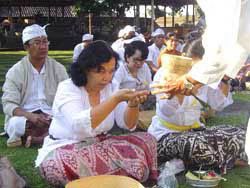 Nowadays, purnama in Sanur is still beautiful, but people do not need to wait to come to the beach on that day. People can come to Sanur every day if they like. Purnama and Sanur no longer have a strong connection. The tall building on Sanur beach, which used to be considered so splendid, has now lost its attractiveness. Also, the number of places for recreation has increased; now it is mainly malls and cafes where teenagers like to hang around at the week end.
Nowadays, purnama in Sanur is still beautiful, but people do not need to wait to come to the beach on that day. People can come to Sanur every day if they like. Purnama and Sanur no longer have a strong connection. The tall building on Sanur beach, which used to be considered so splendid, has now lost its attractiveness. Also, the number of places for recreation has increased; now it is mainly malls and cafes where teenagers like to hang around at the week end.The romantic dimension of the full moon has become less celebrated by teenagers nowadays. Changes have taken place, marked by more spiritual activities, held on purnama day. On the night of purnama, young people around the town of
The spiritual dimension of purnama has been very strong recently. Every purnama, many primary and secondary school students in Denpasar, and in other regions throughout
Using Balinese traditional costume (pakaian adat) is an important development in Balinese society; especially among the young generation. They are proud of their traditions and this is in contrast to what happened in the 1950s and 1960s. Young people were then ashamed to wear Balinese attire. If they went to temple some distance away by bicycle, they tended to wear trousers on the way and kept their Balinese clothes in a bag. They only put them on when they arrived in the temple. After praying, they wrapped up the pakaian adat again and put them back in the bag. However, nowadays, things have changed dramatically and the changes are supported by the promotion of purnama as the day for Hindu students to wear Balinese costume.
Schools have started to use the so-called
Visitors who happen to have purnama during their holiday in
On the day of the full moon, Balinese people usually do tirta yatra or pilgrimage to their family or main Hindu temples such as Besakih, Tanah Lot, and Uluwatu. Some often go to pray to
Although we are focusing upon the full moon in this article, it should be mentioned that 'Tilem', the dark moon, is also an auspicious day in the Balinese calendar.





No comments:
Post a Comment